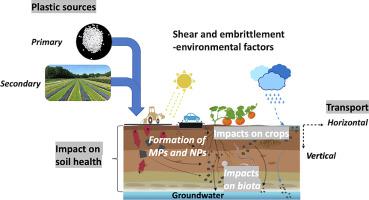NanoImpact ( IF 4.9 ) Pub Date : 2023-07-05 , DOI: 10.1016/j.impact.2023.100474 Anton F Astner 1 , Alexis B Gillmore 1 , Yingxue Yu 2 , Markus Flury 2 , Jennifer M DeBruyn 1 , Sean M Schaeffer 1 , Douglas G Hayes 1

|
Micro and nanoplastics (MPs and NPs, respectively) in agricultural soil ecosystems represent a pervasive global environmental concern, posing risks to soil biota, hence soil health and food security. This review provides a comprehensive and current summary of the literature on sources and properties of MNPs in agricultural ecosystems, methodology for the isolation and characterization of MNPs recovered from soil, MNP surrogate materials that mimic the size and properties of soil-borne MNPs, and transport of MNPs through the soil matrix. Furthermore, this review elucidates the impacts and risks of agricultural MNPs on crops and soil microorganisms and fauna. A significant source of MPs in soil is plasticulture, involving the use of mulch films and other plastic-based implements to provide several agronomic benefits for specialty crop production, while other sources of MPs include irrigation water and fertilizer. Long-term studies are needed to address current knowledge gaps of formation, soil surface and subsurface transport, and environmental impacts of MNPs, including for MNPs derived from biodegradable mulch films, which, although ultimately undergoing complete mineralization, will reside in soil for several months. Because of the complexity and variability of agricultural soil ecosystems and the difficulty in recovering MNPs from soil, a deeper understanding is needed for the fundamental relationships between MPs, NPs, soil biota and microbiota, including ecotoxicological effects of MNPs on earthworms, soil-dwelling invertebrates, and beneficial soil microorganisms, and soil geochemical attributes. In addition, the geometry, size distribution, fundamental and chemical properties, and concentration of MNPs contained in soils are required to develop surrogate MNP reference materials that can be used across laboratories for conducting fundamental laboratory studies.
中文翻译:

微塑料和纳米塑料的形成、行为、特性以及对农业土壤生态系统的影响(综述)
农业土壤生态系统中的微米塑料和纳米塑料(分别为 MP 和 NP)代表了全球普遍存在的环境问题,对土壤生物群构成风险,从而对土壤健康和粮食安全构成风险。本综述对农业生态系统中 MNP 的来源和特性、从土壤中回收的 MNP 的分离和表征方法、模拟土传 MNP 的大小和特性的 MNP 替代材料以及运输等方面的文献进行了全面的最新总结。 MNPs 通过土壤基质。此外,本综述阐明了农业 MNP 对农作物、土壤微生物和动物的影响和风险。土壤中 MP 的一个重要来源是塑料栽培,涉及使用地膜和其他塑料农具为特种作物生产提供多种农艺效益,而 MP 的其他来源包括灌溉水和肥料。需要进行长期研究,以解决目前关于 MNP 的形成、土壤表面和地下迁移以及环境影响的知识差距,包括来自可生物降解地膜的 MNP,尽管它最终会完全矿化,但仍会在土壤中驻留数月。 。由于农业土壤生态系统的复杂性和多变性以及从土壤中回收MNP的难度,需要更深入地了解MP、NP、土壤生物群和微生物群之间的基本关系,包括MNP对蚯蚓、土生无脊椎动物的生态毒理学效应、有益土壤微生物和土壤地球化学属性。此外,需要了解土壤中 MNP 的几何形状、尺寸分布、基本和化学性质以及浓度,以开发可跨实验室用于进行基础实验室研究的替代 MNP 参考材料。



























 京公网安备 11010802027423号
京公网安备 11010802027423号